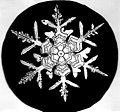
Little Susie Snowflake was born very high above the earth where cirrus clouds occur (35,000 feet) from a tiny amount of water vapor that froze a pattern around a tiny particle of pure salt from sea spray!
At first she was a plain hexagonal crystal of ice but she floated around and around attracting more water molecules and grew stubby arms. Then thin ice filled in the spaces between Susie’s arms. It was about 35 degrees below zero and she slowly grew into a simple little plate snowflake, so small she was barely visible!
She fell from her high perch into a veil of snowflakes with millions of little flakes just like herself and soon landed on the top of altostratus and altocumulus clouds (25,000 feet high.) The top layer of the clouds was still very cold (20 degrees below zero.) As Susie fell through the deck of clouds it got warmer and warmer (14 degrees above zero). There was lots more water vapor and Susie grew 6 more arms with odd little decorations between them and more thin ice formed around her edges. Susie became a large beautiful plate with thickened edges and sharply pointed corners.
She tossed about in the churning clouds and sank into the low stratocumulus clouds of a winter storm. There was even more water to grow on! The temperature was almost 0. She drifted downward growing 6 broad plate-like extensions at each corner.
Susie reached snowflake paradise when she entered nimbostratus clouds with an abundance of water. The temperature was 10 degrees above 0 and she started to grow fast! Needlelike arms started shooting out and branching crystals grew from them until they touch and connect. She continued to branch as she fell and grew armfuls of branching crystals, extending the points and ending them with hexagonal plates.
She became heavy enough in her crystal dress to leave the paradise clouds and fall to the earth. Susie Snowflake might have landed in my yard and become part of a snowman or maybe we ate her in our snow cone! Or Susie could have been part of a glacier or maybe one of the plants in the yard drank her when she melted and she became part of the plant!
Snowflake Bentley from Vermont photographed a snowflake for the first time in 1885 when he was 19 years old. Although ice crystals are clear, scattering of light by the crystal facets and imperfections make the crystals appear white in color. The whole spectrum of light is diffused by the small ice particles. Guinness World Records list the world’s largest snowflakes as those of January 1887 in Montana. Allegedly one measured 15 inches wide. The exact details of the sticking mechanism remain controversial. Possibilities include interlocking, sintering, electrostatic attraction as well as the existence of a “sticky” liquid-like layer on the crystal surface. The individual ice crystals often have hexagonal symmetry.
